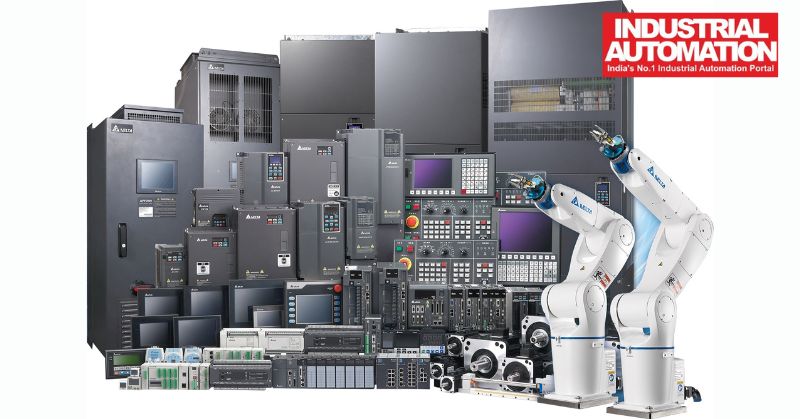
Improving Overall Efficiency in Smart Manufacturing Systems
Machine level automation is transforming smart manufacturing by enhancing productivity, quality, and operational efficiency. With technologies like AI, IoT, and robotics, manufacturers can streamline processes, reduce costs, and improve workplace safety. Manish Walia, head of Industrial Automation at Delta Electronics India, underscores the role of automation in driving sustainable and future-ready manufacturing environments.
![[object Object]](https://admin.industrialautomationindia.in/storage/articles/article-1GPr21F93JnMc5K7GAC0K7CKPk3OYkHafbifoHcz.jpg)
Automation at the machine level can improve overall efficiency in smart manufacturing systems, says Manish Walia.
In today's rapidly evolving industrial landscape, smart manufacturing has emerged as a critical trend, integrating advanced technologies to optimise production processes. This approach leverages real time data and cutting-edge technologies like Artificial Intelligence (AI) and the Internet of Things (IoT) to adapt to shifting customer demands and business needs. Smart manufacturing is defined by its ability to use data from machines and sensors to enhance production efficiency, improve quality, and ensure seamless equipment operation. The integration of these technologies significantly boosts overall productivity and operational efficiency.
For smart manufacturing, machine level automation is a key component that drives significant improvements across various production facets, resulting in more streamlined, efficient, and sustainable manufacturing environments.
Benefits of machine level automation
1. Enhanced Productivity: Machine level automation substantially increases productivity by accelerating production cycles and minimising downtime. Automated systems operate at high speeds with exceptional precision, enabling faster production rates and reducing the time between operations. Unlike manual processes, which are prone to interruptions, automated machines ensure consistent performance, resulting in higher throughput. This increased efficiency allows manufacturers to meet market demands more effectively and maintain a competitive edge.
2. Superior Quality: Automation is a key driver of consistent and superior product quality. Automated systems excel in performing repetitive tasks with high accuracy, reducing the likelihood of human error and minimising defects. Additionally, the integration of advanced sensors and monitoring systems ensures that products consistently meet quality standards. Enhanced traceability features enable manufacturers to monitor the production process closely, identifying and addressing any deviations from quality norms, thereby facilitating continuous improvement and quality assurance.
3. Cost Efficiency: Cost reduction is a significant advantage of machine level automation. By reducing reliance on manual labour, automation lowers labour costs and alleviates workforce management challenges. Automated systems are also more energy efficient, leading to substantial energy savings. Furthermore, automation optimises material usage through precise process control, minimising waste and reducing material costs. Collectively, these cost saving measures contribute to increased profitability and a more sustainable manufacturing operation.
4. Greater Flexibility: One of the most valuable benefits of automation is its ability to adapt to changing market demands and product variations. Automated systems can be reprogrammed or adjusted to handle different tasks or products, enabling manufacturers to respond swiftly to shifts in market trends or production requirements. In today's dynamic market environment, this flexibility is crucial for maintaining a competitive advantage and achieving long-term success.
5. Improved Workplace Safety: Automation at the machine level plays a pivotal role in enhancing workplace safety. By performing hazardous or repetitive tasks, automated systems reduce the risk of accidents and injuries associated with manual labour. Advanced safety features, such as collision detection and emergency stop functions, further protect workers from potential harm. As a result, manufacturers can maintain a safer work environment while adhering to stringent safety regulations.

Key technologies and strategies
1. Robotics: Robotics is central to machine level automation, offering a wide range of solutions from collaborative robots (cobots) to autonomous guided vehicles (AGVs). Cobots work alongside human operators, assisting with tasks and enhancing overall efficiency. Industrial robots, on the other hand, handle repetitive and complex tasks with unparalleled precision. AGVs streamline material handling and transportation within manufacturing facilities, reducing the need for manual labour and improving operational efficiency.
2. Internet of Things (IoT): The IoT connects machines and equipment, enabling real time data collection and analysis. IoT sensors and devices monitor various parameters, such as temperature, pressure, and performance metrics, providing critical insights for optimising machine operations and predicting maintenance needs. This connectivity enhances visibility into the production process, supporting data driven decision making and improving overall system performance.
3. Artificial Intelligence (AI): AI is a transformative technology in machine level automation, offering capabilities like machine learning, predictive maintenance, and optimisation algorithms. Machine learning algorithms analyse data to identify patterns, improving process efficiency and decision making. Predictive maintenance, powered by AI, forecasts equipment failures before they occur, reducing unplanned downtime and maintenance costs. Optimisation algorithms continuously refine production processes, ensuring maximum efficiency and effectiveness.
4. Cybersecurity: As automation systems become more interconnected, cybersecurity is paramount to protecting manufacturing operations. Implementing robust cybersecurity measures, such as encryption, access controls, and regular security updates, is essential to safeguard automated systems from vulnerabilities and threats. Ensuring the integrity and reliability of these systems is crucial for maintaining smooth operations and preventing data breaches.
5. Human Machine Collaboration: Maximising the benefits of machine level automation requires effective integration of human skills with automated systems. Human operators bring critical thinking, problem-solving, and decision-making abilities that complement automated processes. By fostering collaboration between humans and machines, manufacturers can leverage the strengths of both, achieving optimal performance and driving innovation.
Future trends and outlook
1. Emerging Technologies: The future of machine level automation will be shaped by emerging technologies like AI powered vision systems and edge computing. AI powered vision systems enhance the ability of automated machines to inspect and analyse products with high accuracy. Edge computing processes data closer to the source, reducing latency and enabling real-time decision-making. These advancements will further enhance automation capabilities, driving continuous innovation in manufacturing.
2. Industry 4.0: Industry 4.0 represents the next phase of industrial evolution, characterised by the seamless integration of automation with other advanced technologies to create a fully connected manufacturing ecosystem. This paradigm shift includes the convergence of IoT, AI, and robotics to achieve smarter, more efficient manufacturing processes. Industry 4.0 enables greater interoperability, data sharing, and automation, resulting in a more responsive and agile manufacturing environment.
3. Sustainability: Automation plays a crucial role in promoting sustainability by reducing environmental impact and supporting sustainable practices. Energy efficient automated systems contribute to lower energy consumption, while optimised material usage minimises waste. Additionally, automation facilitates the implementation of recycling and reprocessing strategies, further enhancing the sustainability of manufacturing operations.
Conclusion

Machine level automation is a key driver of efficiency in smart manufacturing, offering benefits such as increased productivity, superior quality, cost efficiency, flexibility, and safety. By incorporating technologies like robotics, IoT, AI, and cybersecurity, manufacturers can enhance their operations significantly. However, the scope of automation extends beyond just machine level improvements. Factory and process automation also play critical roles in creating a fully integrated, responsive manufacturing environment. Embracing a holistic approach that integrates technology, people, and processes is essential for unlocking the full potential of automation and achieving success in the modern manufacturing landscape.
A die hard sports enthusiast, Manish Walia heads the Industrial Automation Business Group of Delta Electronics India Pvt Ltd. Besides holding the responsibility of growing Industrial Automation Business in India since 2008, he recently has been entrusted to promote the MVD product line also in India. Manish is responsible for aggressively developing Delta as a brand of choice amongst customers and aligning the market & technological trends with the R&D team.
A 26 years’ veteran in the industry, Manish has worked for industry majors like Crompton Greaves, ABB and Flextronics before joining Delta in 2008. Experienced in various portfolios like Sales, Marketing and Program Management, Manish has a thorough knowledge of the industry. Manish holds a BE degree in Electrical engineering with Honours from Punjab Engineering College, Chandigarh and an advanced diploma in Business Administration from Delhi.
______________________________________________________________________________________________
For a deeper dive into the dynamic world of Industrial Automation and Robotic Process Automation (RPA), explore our comprehensive collection of articles and news covering cutting-edge technologies, robotics, PLC programming, SCADA systems, and the latest advancements in the Industrial Automation realm. Uncover valuable insights and stay abreast of industry trends by delving into the rest of our articles on Industrial Automation and RPA at www.industrialautomationindia.in